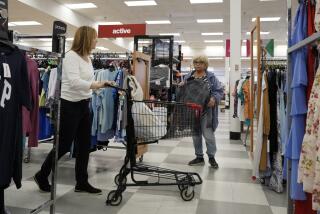Productivity Up, Labor Costs Drop
- Share via
U.S. workers in recent years have been pressed to produce more, although often for modest wage increases that have helped keep their employers’ costs down.
Data released Thursday showed this worker productivity trend gaining a surprising amount of steam in the third quarter, helping explain why the economy and corporate profits are growing solidly even as many workers feel uneasy.
U.S. business productivity -- measuring worker output per hour -- surged at an annual rate of 4.1% in the July-to-September period, the Labor Department reported. It was the strongest increase in more than a year and far surpassed expectations.
Meanwhile, unit labor costs -- what it costs businesses to produce a given output for a set amount of labor -- declined at an annual rate of 0.5% in the quarter, the department said. It was the first drop in this key indicator of corporate profitability since the second quarter of 2004.
The results were “a remarkable achievement and a testimony to the flexibility of resources in the economy,” said Brian Bethune, an economist for Global Insight, a research firm in Waltham, Mass.
Although the “stunning” numbers are unlikely to be repeated in the current quarter, “the strong underlying productivity trends in the economy are expected to continue,” he said.
For many companies, boosting productivity while managing labor costs -- often through better technology, workplace changes or outsourcing -- is a necessity to compete against lower-cost foreign and U.S. rivals. It’s not just a mantra for high-cost, old-line industries such as airlines or automakers. In Silicon Valley, state-of-the-art technology companies are producing more to meet increasing orders, but employment growth in the region has been anemic.
Strong productivity gains normally could support higher wages. But although growth in overall compensation -- wages and benefits together -- has surpassed inflation, wage boosts alone have not. That could help explain why surveys show that many workers are unsettled about the economy, even though it is growing at an above-average pace, analysts say.
Higher productivity has done one thing well: It has boosted profits. And it is often cited by Federal Reserve Chairman Alan Greenspan as a necessity for the economy to grow strongly without inciting higher inflation.
Thursday’s data helped spark a modest stock market rally. And by suggesting reduced inflationary pressures, the data also could lessen the need for more aggressive interest rate hikes by the Fed.
Indeed, at least one business analyst Thursday urged the Fed to back off.
“With productivity growth keeping a lid on labor costs, one can question further Fed action to guard against inflation,” said David Huether, chief economist at the National Assn. of Manufacturers.
Noting that high costs for energy, healthcare, litigation and regulatory compliance are making U.S. manufacturers less competitive compared with foreign companies, Huether said, “Unnecessary rate hikes by rote only stand to exacerbate that competitive disadvantage.”
The third-quarter productivity growth easily beat economists’ expectations of a 2.6% rise and trumped a revised 2.1% increase in the second quarter, the Labor Department reported. The result was aided by a decline in hours worked in the hurricane-battered Gulf Coast region, and thus could be revised downward later, economist Bethune suggested.
It was the strongest productivity jump since a 4.5% gain in the second quarter of 2004.
The unit labor cost decline blew away expectations of a 2% gain and followed a revised 1.8% rise in the April-June quarter.
Other economic reports Thursday also showed a surprisingly resilient economy that has weathered hurricanes and higher energy costs.
Growth in the service sector exceeded expectations in October, according to the Institute for Supply Management. The group’s service index grew to 60 last month from 53.3 in September, topping forecasts of a rise to 57. Any reading above 50 indicates growth in services, which account for about 80% of the economy and include sectors such as financial services and transportation.
The Labor Department also reported a third consecutive weekly decline in first-time claims for unemployment benefits as the effects of hurricanes Katrina and Rita wear off. They fell to a seasonally adjusted 323,000 in the week ended Oct. 29 from an upwardly revised 331,000 in the previous week.
In another report, the Commerce Department said new orders at factories fell 1.7% in September, more than the forecast decline of 1% and down from a revised 2.9% increase in August.
More to Read
Inside the business of entertainment
The Wide Shot brings you news, analysis and insights on everything from streaming wars to production — and what it all means for the future.
You may occasionally receive promotional content from the Los Angeles Times.










